|
Out and Back
The story of a Bomber Crew
Of 149 (East India ) Sqn R.A.F.
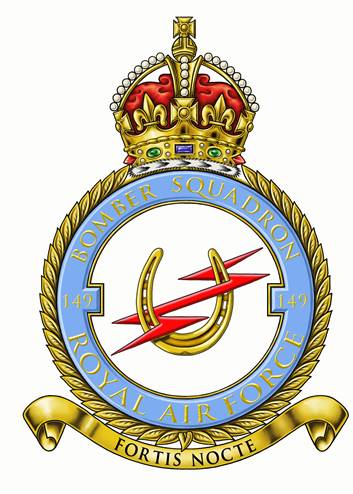
The Squadron.
During World War Two 149 (East India) Squadron, was based at RAF Mildenhall, RAF Lakenheath and latterly, RAF Methwold. The squadron was re-formed in 1937 at Mildenhall as a night-bomber unit and equipped with Heyford aircraft. Wellingtons were received early in 1939. The squadron played a prominent part in the early offensive against Germany and Italy and after having re-equipped with Stirlings, took part in the first 1,000-bomber raids. It went on to serve steadfastly until the end of the war, with a Victoria Cross awarded to one of its pilots.
The Crew.
1193117 Sgt DA Baker – Captain (Pilot Evaded capture
NZ 41530 Sgt FJ Berthelsen – Observer Evaded capture
574193 Sgt J B Downing - F/Engineer Injured - POW
993644 H Williams – Wop Evaded capture
1011435 G Robinson – A/G Evaded capture
1379417 Sgt T J Jenkins - A/G Evaded capture
1376387 F/Sgt V S Wood - A/G Injured - POW
(Sources, 149 Sqdn Operational Record Book; W R Chorley, Bomber Command Losses of the Second World War, Volume 3.)
The Aircraft.
Short Brothers Stirling Mk 1, serial W7572. coded OJ-R 149 Sqn, RAF. Built by Austin Motors. This aircraft arrived at 149 Sqdn from No 10 Maintenance Unit (10MU) on the 14th June 1942.

(Note: Aircraft shown is OJ-B, a Mk 1 of a similar vintage.)
The Operation.
Frankfurt - 24/25th Aug 1942.
226 aircraft took part in this raid. 104 Wellingtons, 61 Lancasters, 53 Stirlings and 8 Halifaxes. 16 aircraft were lost - 6 Lancasters, 5 Wellingtons, 4 Stirlings and 1 Halifax. This was 7.1% of the force sent. 5 Pathfinder aircraft, including that of the commanding officer of 7 Squadron were among the aircraft lost.
This was the second Pathfinder-led raid and the Pathfinder crews again experienced great difficulty in locating the target in cloudy conditions, most of the bombing fell in open country north and west of Frankfurt. Local reports say that some bombs fell in the city, with 17 large and 53 small fires and with moderate property damage. 5 people were killed, including 2 flak gunners, and 95 people were injured. The Frankfurt report describes an incident where a four-engined bomber crashed on the edge of a metal works and its bomb load exploded. The outlying villages of Schwalbach and Eschborn were heavily bombed.
(Source: The Bomber Command War Diaries: Martin Middlebrook & Chris Everitt.)
The Operation.
OJ-R took off from Lakenheath at 21.20. The Squadron Operational Record Book (ORB) simply states: “Aircraft failed to return”. (Entry No 3).
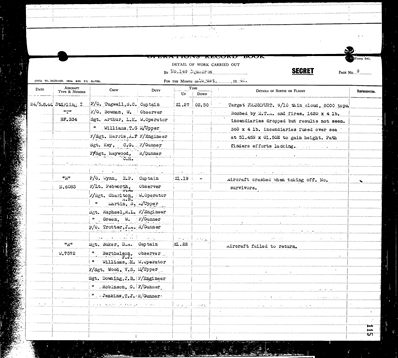
The Reason.
The aircraft was shot down by Oberfeldwebel (Ofw) Reinhard Kollack of 7/NJG4 and crashed at 01.46 near Thieulain (Hainaut) 12 Km E of Tournai, Belgium. (Also given in the NJG intercept records as : bei Leuze, 27 Km NW of Mons at 3,600m) Ofw Kollack made three attacks on the aircraft during which two crew members were slightly injured.
The German Raid Records.
The German records on this raid state:
“226 aircraft were despatched to bomb Frankfurt between 23.40 and 00.38 hrs. 16 of their number failed to return. Aided by the prevailing fine weather with good visibility, an almost full moon and no cloud, Nachtjager (Night Fighter Aircraft) from NJG 1 and NJG 4 operating in Dunkel Nachjagd (see Note) over Belgium and Northern France shot down 14 Heavies, mainly on the Bomber’s return track. These included Raume 7A and 7B, situated at Aisemont and Villers-deux-Eglises near Charleroi respectively, in which III./NJG4 achieved eight victories on this night……( The ‘Raumes’ referred to are Night Fighter Control Boxes)”
(Note: from Nachtjagd War Diaries Vol 1 Dr Theo E W Boiten “)
(Note: Dunkel Nachtjagd (DUNAJA or Dark Night Fighting) employed Freya A/N-Verfahren( Ground Control Intercept radar), which ensured that both the fighter and the bomber were tracked by 1 Freya and displayed on 1 Alpha scope. Initially DUNAJA sites were equipped with 1 Freya AN and one Würzburg (Radar) for height finding.)
The Crew History.
Sgt Pilot Baker (and presumably his crew) were posted in to 149 Sqn on 7th May 1942.
Sgt Baker did his first “Familiarisation” Operation on 30th May ’42, with Flt Lt Simmons and his crew, as a trip to Koln. They reported: “Bombs dropped in middle of town, west of river. A number of 4lb incendiaries hung up and were brought back. Many fires observed, concentrated in suburbs”.
(Note: John Johnston, the author of the 149 Sqdn history, “Strong By Night”, recalls, “Incendiaries were carried in crates that reminded me of banana boxes. The crate doors open to drop the loosely packed incendiaries, with the crate remaining in the bomb bay. When they don’t (drop), the crate of incendiary bombs is brought back. Sometimes the doors open afterwards dropping the incendiaries on the closed bomb doors”.
Sgt Baker also took a 149 Sqdn Conversion Flight aircraft (“C” Flt), Stirling 1, OJ-Z, serial N3682, to Essen on an Operation. One of his crew on that trip was a current (now deceased AF) Mildenhall Register committee member, Wireless Operator Sgt Jim Coman, DFC
(Source: http://www.mildenhallregister.stirlingpilot.org.uk)
The full “Baker” crew operational history is as follows:
1st Op - Stirling I, serial R9329 coded OJ-V
16th June ’42 Target – Le Mans, Nickeling (Propaganda Leaflets)
Take Off (T/O) at 23.57 from RAF Lakenheath, landing at 05.01 with 80 “nickels” dropped.
9 Aircraft on mission. No losses
2nd Op - Stirling I, serial R9329 coded OJ-V
17th June ’42 Target – St Nazaire Docks.
T/O at 22.58 from Lakenheath, landing at 05.17. Dock area not identified due to 9/10ths cloud. Half bomb load jettisoned at Berness Heath and rest brought back.
27 Stirlings and Wellingtons went to St Nazaire, but only 6 bombed in poor weather. No Losses
3rd Op - Stirling I, serial W7510 coded OJ-S
19th June ’42 Target Emden
T/O at 23.45 from Lakenheath, landing at 03.37 . Bombs released on TR. release point. No bursts or results seen. Glow in target area.
(Note: In early '42 “Gee” was added to the navigation aids of Bomber Command, with the plan to gradually fit it throughout. As a test run, two aircraft had used “Gee” on a raid to Hanover. One was shot down, with the possibility that the Germans already had a “Gee” set, although “Gee” was fitted with a detonator which should have destroyed part of the indicator and the crystal oscillator.
They knew that as soon as the Germans could get their hands on a working set it would be compromised, so they held off installing it until they had enough sets. However the aircraft were coming off the assembly lines with the appropriate indicator and receiver trays already installed. They needed to do a little misdirection.
To facilitate this misdirection, they gave air crews the information that a new “beam approach” system was coming along, called 'Jay' (as that sounded enough like “Gee”, and the aircraft had these trays all marked TR1335, (Hence TR) although “Gee” doesn't have a transmitter. They knew that any air crew shot down and interrogated would give the “Beam Approach” story. They even transmitted a 'beam' now and then, that was close to the “Gee” frequency and that looked like a Lorenz Beam. Sure enough, it wasn't long before Intelligence learned that the Germans 'knew' about the new non-existent Jay equipment!
When “Gee” did go into service, which was the Mk I, the air crew still called it by what was on the tray, TR1335, or simply 'TR'. This was invaluable for target marking as it could get the aircraft approximately to the target in the dark for targets within 400 miles, also for mine laying as the position of each of each mine laid needed to be known for post-war mine sweeping.)
194 aircraft – 112 Wellingtons, 37 Halifaxes, 25 Stirlings, 11 Hampdens, 9 Lancasters. 9 aircraft lost – 6 Wellingtons, 2 Stirlings, 1 Halifax. 131 crews claimed to have bombed Emden. Bombing photographs showed that part of the flare force started a raid on Osnabruck, 80 miles from Emden, in which 29 aircraft eventually joined. Emden recorded only 5 high-explosive bombs and 200-300 incendiaries with no damage or casualties.
4th Op - Stirling I, serial N6082 coded OJ-Q
22nd June ’42 Target Emden
T/O at 23.45 from Lakenheath, landing at 04.30 . Bombs released on TR. release point. Bursts seen in town area. All bombs dropped.
227 aircraft – 144 Wellingtons, 26 Halifaxes, 38 Stirlings, 8 Hampdens, 11 Lancasters. 6 aircraft lost – 4 Wellingtons, 1 Stirling, 1 Lancaster. 196 crews claimed good bombing results, but decoy fires are believed to have drawn off many bombs. Emden reports 5o houses destroyed, 100 damaged, damage in the Harbour, 6 people killed and 40 injured.
5th Op - Stirling I, serial R9329 coded OJ-V
2nd July ’42 Target Bremen
T/O at 23.26 from Lakenheath, landing at 03.59 . Bombs thought to have fallen in Newtown. Bursts seen to start three small fires. TR not working.
325 aircraft - 175 Wellingtons, 35 Halifaxes, 34 Stirlings, 28 Hampdens, 53 Lancasters. 13 aircraft lost – 8 Wellingtons, 2 Stirlings, 2 Hampdens, 1 Halifax. 265 crews claimed to have bombed in good visibility, but it is probable that much of the attack fell outside the southern borders of the town. A brief Bremen report say that more than 1,000 houses and 4 small industrial firms were damaged. 3 Cranes and 7 ships in the port were also hit. 1 of the ships, the 1,736-ton steamer “Marieborg” sank and it is recorded as having become a danger to navigation. Only 5 people were killed and 4 injured…..
6th Op - Stirling I, serial N3755 coded OJ-S
7th July ’42 Target Freisians - Mining
T/O at 00.27 from Lakenheath, landing at 04.37 . T/R. not serviceable but mines laid within 5/6 miles of allotted position.
23 Stirlings on mission. No losses.
7th Op - Stirling I, serial N3755 coded OJ-S
8th July ’42 Target Wilhelmshaven
T/O at 00.13 from Lakenheath, landing at 04.02 . Docks clearly seen in light of flares. Bombs dropped and bursts seen on Bauhaven. Fires seen burning well in dock area.
285 aircraft - 137 Wellingtons, 38 Halifaxes, 34 Stirlings, 24 Hampdens, 52 Lancasters to bomb the dock areas. 5 aircraft lost – 3 Wellingtons, 1 Halifax, 1 Lancaster. Photographs showed that most of the bombing fell in open country west of the target. Wilhelmshaven reports damage to housing and a variety of other premises. The harbour master’s residence and offices, a dockyard restaurant, a department store and a bus garage with 30 buses inside which were all destroyed. 25 people were killed and 170 injured.
8th Op - Stirling I, serial W7572 coded OJ-R
21st July ’42 Target Duisburg
T/O at 00.03 from Lakenheath, landing at 03.35 . Target clearly visible and confirmed with T/R fixes. 1800 x 4lb Incendiaries dropped in old town. Many fires seen in target area. 4 bundles of “Nickel” dropped in area.
291 aircraft – 170 Wellingtons, 39 Halifaxes, 36 Stirlings, 29 Lancasters, 17 Hampdens. 12 aircraft lost – 10 Wellingtons, 1 Halifax, 1 Hampden. 235 crews reported that they had bombed and started many fires, but photographs show that the flares of the leading aircraft, dropped by Gee were not accurate and part of the bombing fell in open country over the Rhine to the west. This large raid was possibly sent on a moonless night to avoid the increasing casualties being inflicted on night-bomber forces by German night fighters. It is interesting to note that the bombing results were better than on many moonlit raids but the bomber casualties at 4.1%, were heavier than normal. Returning crews reported that Duisburg’s Flak and searchlight defences werenot as fierce as in recent raids to that target because of the haze, most of the bomber losses were suffered in the coastal fighter belt.
Duisburg reports much damage in housing areas, 94 buildings being destroyed and 256 being seriously damaged, with 49 people being killed.
9th Op - Stirling I, serial W7572 coded OJ-R
23rd July ’42 Target Duisberg
T/O at 00.57 from Lakenheath, landing shortly after. Aircraft returned as rear turret and oil pump on stbd inner engine U/S.
(Note: On the Stirling, the rear turret was powered by hydraulic fluid from the starboard inner engine)
10th Op - Stirling I, serial W7572 coded OJ-R
25th July ’42 Target Duisberg
T/O at 00.34 from Lakenheath, landing at 03.45 . 8/10ths cloud. Bombed by TR Fix. Bombs fell near burning fires, huge explosion seen, believed oil from observed oil tank. 6 bundles of “Nickel” dropped in area.
313 aircraft - 177 Wellingtons, 41 Halifaxes, 48 Stirlings, 45 Lancasters. 7 aircraft lost – 3 Wellingtons, 2 Lancasters, 2 Stirlings. Much cloud was present over the target and the flares dropped by the leading aircraft were scattered. Those bombs which did fall in Duisberg again caused some housing damage and 65 people were killed.
11th Op - Stirling I, serial W7572 coded OJ-R
26th July ’42 Target Hamburg
T/O at 23.04 from Lakenheath, landing at 04.14 . Target good vis(ibility) and pinpoints. Bombs dropped in built up area North of the river, E of aiming point. Good fires seen in target area. 6 bundles of “Nickel” dropped in area.
403 aircraft -181 Wellingtons, 73 Halifaxes, 39 Stirlings, 77 Lancasters, 33 Hampdens. – dispatched in what was probably a full “maximum effort” for the regular bomber command squadrons.29 aircraft lost – 15 Wellingtons, 8 Halifaxes, 2 Lancasters, 2 Stirlings, 2 Hampdens – 7.2% of the force.. Crews encountered a mix of cloud and icing at some places on the route but clear weather at the target. Good bombing results were claimed. Hamburg reports show that severe and widespread damage was caused, mostly in housing and semi-commercial districts rather that in the docks and industrial areas. At least 800 fires were dealt with, 523 being classed as large. For the first time, the strong Hamburg fire department was forced to call for extensive help from outside the city. 823 houses were destroyed and more than 5,000 damaged. Estimates of compensation for damage claimed ran to 250 million Reichmarks ( around £25 million). More than 14,000 people were bombed out. 337 people were killed and 1,027 injured.
12th Op - Stirling I, serial N3755 coded OJ-S
28th July ’42 Target Hamburg
T/O at 23.33 from Lakenheath, landing at 05.01. Visibility very poor. Target identified by visual pinpoint of river and fires. Bombs dropped slightly E.N.E. of Alster Basin. 4 bursts seen – no results. 4 bundles of “Nickel” dropped in area. Photo’ attempted but not good due to evasive action at that time.
256 aircraft –165 from 3 Group, and 91 O.T.U. aircraft – A much larger force had been detailed for this raid but bad weather over the bases of 1,4 and 5 groups prevented their participation. The force which took off was 1612 Wellingtons, 71 Stirlings and 24 Whitleys. The weather, both on the outbound flight and over the English bases, worsened and the OUT aircraft were recalled, although 3 of them went on to bomb Hamburg. The bombers which did proceed became very scattered, many aircraft turned back and only 68 bombed in the target area. Hamburg suffered 13 people killed and 48 injured with 56 fires, 15 of them large. The worst incident was a direct hit on a ward of the Eppendorf Hospital, where 12 patients and nurses were killed and 39 injured. Bomber losses were heavy. 16 Wellingtons and 9 Stirlings were lost from 3 Group (15.2%) 4 OUT Wellingtons were lost and a Whitley crashed in the sea.
13th Op - Stirling I, serial W7572 coded OJ-R
31st July ’42 Target Dusseldorf
T/O at 01.02 from Lakenheath, landing at 04.23 . Cloud Nil, but ground haze and smoke. Bombs dropped in built up area east bank of the Rhine. Good fires seen in target area. 4 bundles of “Nickel” dropped in area.
630 aircraft -308 Wellingtons, 70 Halifaxes, 61 Stirlings,113 Lancasters, 54 Hampdens, 24 Whitleys. – dispatched. This was another raid in which bomber command’s training units provided aircraft, though it was not an attempt to reach the 1,000 aircraft figure. It was the first occasion when more than 100 took part in a raid. 484 aircraft claimed successful bombing although their photographs showed that part of the force bombed open country. Most parts of Dusseldorf and Neuss,the suburb town over the Rhine were hit. 453 buildings were destroyed and more than 15,000 damaged. 954 fires were started, of which 67 were classed as large.279 people were killed and 1,018 injured and 12,053 bombed out. 29 aircraft were lost. 16 Wellingtons, 5 Hampdens, 4 Halifaxes, 2 Lancasters and 2 Whitleys for 4.6%.
14th Op - Stirling I, serial W7572 coded OJ-R
5th Aug ’42 Target Essen “B”
T/O at 22.50 from Lakenheath, landing at 01.36 . Aircraft returned – no cloud cover.
17 Aircraft to Essen. Only 1 aircraft bombed.
15th Op - Stirling I, serial W7572 coded OJ-R
9th Aug ’42 Target Osnabruck
T/O at 00.31 from Lakenheath, landing at 04.29 . Slight haze. 5 x 1900lb bombs seen to burst in fires in built up area. 6 bundles of “Nickel” dropped in area. Fires visible for almost 100 miles after leaving target area.
192 aircraft -91 Wellingtons, 19 Halifaxes, 40 Stirlings,42 Lancasters – dispatched.3 Halifaxes and 3 Wellingtons lost. Visibility was good but the initial flares were dropped over a wife area. Osnabruck’s report shows 206 houses and 1 military buildings were destroyed and nearly 4,000 other buildings were damaged. Among industrial buildings hit were a vehicle works, a gas meter factory, a textile factory and an iron foundry The Herz Jesu church was hit. Much damage was also caused in the town’s dock area where 10 canal barges were damaged. 62 people were killed – 40 civilians, 17 foreign workers, 5 service or air-raid men and 107 injured. This was the first night where the Germans managed to jam the Gee signals used for targeting.
16th Op - Stirling I, serial R9329 coded OJ-V
12th Aug ’42 Target Mainz
T/O at 22.46 from Lakenheath, landing at 04.40 10/10ths cloud, base 9000 ft. Target identified by river and ETA. 1800 x 4lb incendiaries seen to ignite. Glow seen for 50 miles.
154 aircraft - 68 Wellingtons, 25 Halifaxes, 28 Stirlings, 33 Lancasters – dispatched. 6 aircraft lost. 2 Halifaxes, 3 Wellingtons and one Lancaster. This was the first large raid on this city. Much damage was caused in the centre of Mainz, with some ancient cultural buildings being hit; the castle and its museum were burnt out. The number of people believed killed was 152.
17th Op - Stirling I, serial W7589 coded OJ-P
17th Aug ’42 Target Osnabruck
T/O at 22.46 from Lakenheath, landing at 04.40 5/10ths cloud, base 9000 ft. Target identified. 1950 x 4lb incendiaries seen to ignite north of fire in built up area. 6 bundles of “Nickel” dropped in area.
Attacked on return by enemy fighter, returned from Dutch coast on two engines, crash landed near RAF Feltwell. English searchlight assistance was of great moral and material significance.
139 aircraft -. 5 aircraft lost. 3 Wellingtons, 1 Stirling and 1 Lancaster.3.6% losses. 111 crews reported accurate bombing. Osnabruck reported a sharp attack on the north and north-western parts of the town with 77 houses and 4 military buildings destroyed and 125 other buildings seriously damaged, including the town’s main hospital, a paper mill and a copper wire factory. 7 People were killed and 15 injured.
(Note: Reference the “searchlight assistance” mentioned in the ORB… The crew could have used ‘Darky’. 'Darky' was a code word, put out verbally by the wireless operator when an aircraft was lost or in distress. He called out "Darky!...Darky!..." much as he'd be calling "SOS'. This was picked up by ground stations, who then coordinated on his signal then triangulated to give him his position. They could do this all the way until he got back to his base or landed at another one. This was before Gee, when he could get a very good location, or if the Gee set was unserviceable.
An alternative to ‘Darky’ was achieved through the rarely mentioned Royal Observer Corps. They would pick up the aircraft location and pass it on to the nearest searchlight battery. The battery would then lock on to the ‘plane with one searchlight. Then, after a few seconds, they would sweep the searchlight in the direction that the plane needed to go. They would do this over and over again, even handing over to another ‘light if necessary, to get the plane to its own base or to one where they could land. It saved many a crew. …Information from J. Johnston.)
This ORB Entry hides a story as well. Sgt Williams wrote about it to his wife :
Sgt’s Mess, RAF Lakenheath. 1942.
…. I am sorry about the previous letter, but I had got it half written and intended finishing it just before going on another trip, when things were rushed up and I carried the half finished letter in my pocket and found it still there after many fateful and varied incidents.
I will tell you of these now, it was the night before last. The trip to Osnabruck again (Germany). We got there, arrived rather late, found our target and dropped our stuff, and then went round and photographed it. Then the guns caught us, and at first go with the searchlights got one of our engines, almost lifting us out of the sky. A fighter came after us and luckily didn’t persist so we limped on, and then when we got into Holland another of the engines went for a Burton. It is practically unknown for one of these kites to go on two engines so we were all prepared to bail out. I realised one of a Wireless Operator’s ambitions and banged out those fateful S.O.S’s. We struggled on to the sea, to come down there because one of the two remaining engines was going half cock-eyed. We were losing height all the time and very quickly. So while Douggie (Baker, the Pilot) was doing a marvellous job of work nursing the kite along over the sea, myself tapping away on the wireless, the others were throwing all the loose fittings out of the kite, chairs, ammunition etc. We were all certain that a chance to show our rowing skills had come at last. By this time we only had one and a half engines, but we chugged on, on what we thought was a loosing battle, and eventually came into sight of the English coast. It was grand, the searchlights out, trying to help us along, we had asked them to. So we thought we would make Base.
But 12 miles before Base the petrol ran out, it was all very sudden, we had to come down and take our chance, it was still dark. We took up our positions on the floor, bracing ourselves. We came down batting away at 200 miles an hour. Douggie saw a cottage looming up and managed to get over it, then we hit the deck, ploughed along a corn field, hit a concrete road running through it, and finally finished up in a potato field. Out of the dust, haze and soil we scrambled out of the kite, over the wings and did a war dance of joy. The kite lying on its belly was pranged good and proper, nobody hurt just superficial scratches etc. We were torn, dirty but very happy. We had been flying for six and a half hours.
It was a marvellous feeling to get away with it after thinking all was up.
We walked along the road, it was just breaking dawn then, and then the populace of the surrounding farms started turning out to meet us, a bit timid at first, thinking we might be Jerries, but we soon got over that and then into the various cottages and being plied with food and drink. Everyone was fine towards us and you can imagine how we felt.
You know how I dislike rum, but when we were offered a cupful each I didn’t have any qualms about knocking it back.
Then the Group Captain and everybody motored out to us , and we finally arrived back at camp at nine o’ clock, twelve hours after starting out, and so to bed. ………..
(Note: Courtesy of Mrs V. Wright, Daughter of Sgt Williams.)
18th Op - Stirling I, serial BF334 coded OJ-T
20th Aug ’42 Target Gardening, Deodars.
T/O at 20.39 from Lakenheath, landing at 04.25 5/10ths cloud, good moon. Vegetables planted in allotted positions. (a very laconic comment for the dropping of Mines - Operations known as “Gardening”!)
57 aircraft laid mines at many places from Brest to Danzig. 3 Stirlings and 3 Wellingtons were lost.
19th Op - Stirling I, serial W7572 coded OJ-R
24th Aug ’42 Target Frankfurt
T/O at 21.22 from Lakenheath, Failed to return.
(Note: All Operations notes taken from the’ Bomber Command War Diaries’ by Middlebrook and Everitt)
Three of the shot down crew found their way into the hands of Belgian “Helpers” and then the Pat O’Leary (Escape) Line, with Baker and Williams following different paths until re-uniting with them later. Wood and Downing were captured and became POWs.
At the debriefing for MI9 the Evaders gave the following statements:
Statement by 1193117 Sgt Baker. D.A.
I came down about a mile from the aircraft, near Thieulian, and walked in cover of the woods until about dawn. I got a meal at a farmhouse, but the people were afraid to keep me, so I went back to the woods and slept there all day. At night I walked S.E. , again in the woods. I rested at dawn near an isolated farmhouse, where I was later given a meal. The farm people hid me in the woods and brought me meals regularly for the next five days and allowed me to sleep in a barn at night. I was then taken to Vezon where I was sheltered for four days. On 5th Sept I cycled to Tournai, where I was handed over to an organisation.
Statement by 1011435 Sgt Robinson. G.
I came down 3 miles S.E. of Leuze, hid my parachute at the corner of a wood and walked towards the French frontier. About daylight I hid in a potato field but a dog began to bark and a farmer discovered me. I told him who I was and he brought me food throughout the day. He got in touch with a friend, who put me into an empty house a short distance from Leuze. I remained there from the 25-29 Aug. and local farmers brought me food and water. On 29th Aug. I was moved to another house in Leuze, where I remained ‘til 4th Sept. I was supplied with new clothes and shoes. On 4th Sept. I cycled from Leuze to Tournai and saw Sgts Jenkins and Berthelsen. I spent that night at Herta on the Belgian side of the frontier, and next day (5th) was taken to Lille.
Statement by NZ 41530 Sgt Berthelsen. D.A.
I came down, probably near Thieulain and walked until about 07.00 hrs. I then lay up all day in a bush and started to walk at night. After two hours I was threatened by two men with clubs who found me picking currants in a garden. I had a revolver with me and stopped them from attacking me. When I explained who I was, they suggested a bottle of pale ale and took me to a field, where there were about 15-20 men. They then took me to a farmhouse near Vezon, where I got civilian clothes and shelter for the night. As the whole village knew of my presence, I was moved to Fontenoy, where I remained until 31 Aug. I then cycled to Tournai, where I was handed over to an organisation.
Statement by 1379417 Sgt Jenkins. T.J.
II cam down at Thieulain, near Leuze, Belgium about 01.30 hrs on 25th Aug. I hid all my kit under a hedge and walked for about 4 hrs towards the French border. I went to sleep in an orchard and awoke to find someone beside me. This man took me into a house and I was given food and a bed. I was wakened about 19.00 hrs and taken to Tournail on a motor bicycle and handed over to an organisation.
Statement by 993644 Sgt Williams. H.
I came down on the outskirts of Leuze (Belgium) about 01.30 hrs. 25 Aug. I walked to a cottage about a quarter of a mile away. The people took me to a hiding place in the woods and, during the few days I was there, brought me food and provided me with clothes and a map.
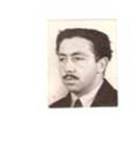 Sgt H Williams. (Photo courtesy of his daughter, Mrs V Wright) Sgt H Williams. (Photo courtesy of his daughter, Mrs V Wright)
I then began walking south alone. I slept out, stopping at houses for meals and directions. None of those who helped me knew of organisations. The first stages of my route were: Leuze -Conde – Marchipont - Erquennes (S.W. of Mons). I crossed the frontier near Erquennes without difficulty. The original frontier signposts were still there, and there were very few Gendarmes about on either the Belgian or French side.
After crossing the frontier I skirted Bavai, and went on to Maubeuge. I then kept east and slightly south and re-crossed the frontier into Belgium east of Thirimont. From Thirimont my route was, Clermont – Boussu - Silenrieux – Chimay – Pesche – Bruly de Pesche – Le Bruly – Hiraumont. I was again in France, having crossed the frontier between the last named places. My problem now was to get across the Meuse, so I went north through the Ardennes to Fumay, which lies between the frontier to the west and the Meuse on the east. Here I was arrested by gendarmes and taken to their office. They informed an officer and he sent a message that I was to “…get out of the way… immediately”.
I continued north and crossed the Meuse by the next bridge, which was just south of Vireux. I kept east from Vireux and again crossed into Belgium. I walked south by the following route:- Willerzie – Rienne – Louette St. Denis – Bellefontaine – Orchimont – Bohan. There I spoke with two old people who brought a man who spoke English. He said he had a friend at Muno (on the Belgian side of the frontier about 10 miles E.N.E. of Sedan), who might be able to help me. I went to this man, a local official, but he did not receive me very cordially, being chiefly interested in French P/W. He did, however, arrange for me to cross the border with two French escapers, with whom I went to Carignan. The hotel at which they were meant to stay refused to have me, as I was not French, but an Architect working on some new buildings put me up for the night.
Next day I went by tram to Charleville with a party of 12 French escapers. I spent two days in a lodging house and was provided with an identity card complete with photograph. I was described on the card as a deaf-mute. I was sent from Charleville to Besancon by train with a French escaper as a guide. On leaving Belgium I had 650 Frs got from farmers and peasants in small sums. With this money I was able to pay my railway fare to Besancon. In Besancon the man who was to have helped us was gone, and very soon my French companion disappeared. Deciding to go on alone, I walked south from Besancon to the Line of Demarcation, which I crossed to Chamblay. I crossed the line at midday, when the guards are lax. The border at that point is a road, and the road and adjacent fields are patrolled. At Chamblay I was advised in a café to make for Lyons. I started walking again, and when I got to Ounans about three miles away, I met a man who put me in touch with an organisation. By this time I had been travelling for about a fortnight, almost all the time on foot, and had walked about 200 miles.
The two captured crew were held as POWs until the end of the war.
574193 Sgt J B Downing – Prisoner of War.
Sgt Downing was injured in the Night Fighter attack and was unable to evade, so was captured. After he has been thoroughly vetted by the Germans he was given a second serial number to show his German POW Identity . He was probably initially placed in Stalag Luft LIII, in Sagan and Balaria, Germany ( as was Flt Sgt Woods) before going to Stalag Luft LVI, (the L denotes that it came under Luftwaffe jurisdiction; VI is roman numerals used by the German to number their camps, in this case “Six”). LVI was Heydekrug in Lithuania. This camp opened in June ’43 and closed in July ’44 and Camp LVI was transferred to St Wendel in Germany in August ’44, closing in September ’44 on the approach of the Russians.
1376387 F/Sgt V S Wood - Prisoner of War
Flt Sgt Wood broke his ankle during his parachute landing and so was unable to evade. He was quickly captured (His POW number was 69103) and his POW camps in sequence are as follows:
LIII Sagan and Balaria Germany
LVI Heydekrug Lithuania
LIV Beninia Poland
LI Barth Germany
(Note: Information from ‘Footprints on the Sands of Time’ (RAF Bomber Command Prisoners of War in Germany 1939-1945) by Oliver Clutton-Brock.)
The Belgian Assistance
Account by Belgium Helpers…..
“On (night) 24 Aug. 1942, an Allied plane had been shot down in Thieulain. Of its seven occupants, two were injured and five others tried to escape the German search. The village was surrounded. Learning that three of them had found temporary refuge in Fourths, we decided to go (and) look for them to try to make them go to France. On Aug. 25, we put our plan into execution. Roger went on a motorcycle at night and managed to bring back Thomas John Jenkins from South Wales, John Frederick Berthelsen and Geoffrey Robinson of London and Yorkshire.
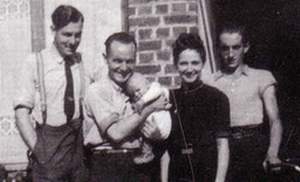
Berthelsen and Jenkins with Micheline Fourez. 27th Aug 1942
(Note: Information from a sprightly 92 year old John Berthelsen has stated that he is not actually in this photograph. It may be that the tall person on the left of picture is Geoffrey Robinson. Alan F, Oct 2012)
While some left us pretty quickly, the first two found shelter with us for ten days. Ms. Bayet, who lived on the street from the Yser in Tournai, often brought them food. This was useful because, at that time, five people lived here. On Sept 5, Roger and René Donneux led the two airmen by train to Blandain. They also had along a German convoy. They moved to a safer shelter and returned to England as well.
They sent us a brooch representing an Indian head in remembrance of what we could do (had done) for them. While the British were here, a gun was hidden under the couch! Railway men carried it to the station of Tournai in a truck of the SNCB, to be where it would be more useful.”
(Note: From “The house with Open Doors”. Nelly Radoux (called Micheline), wife of Roger Fourez. 116 rue Guillaume Charlier in Tournai. The gun referred to was probably Berthelsen’s revolver.)
Another account said : “The evading crew seem to have made their way - brought by local helpers - to the Lille area, which was a centre of activity for the Pat line at that time. According to Louis Nouveau's book, Jenkins and Berthelson were brought down to Marseille by Jean de la Olla (boss of the Pat line's Paris operation at that time) while Baker and Robinson were brought down by Nouveau himself. Williams seems to have evaded by himself for a couple of weeks, reaching Ounans near Dole before finding any organised help
Baker and Robinson are recorded at Louis Nouveau's on 2 September while Jenkins and Berthelson didn't arrive until 2 or 3 October. Note that although recorded by Nouveau, this was around the time of the big break-out from Fort de la Rivere and so many of the escapers and evaders were actually sheltered at other addresses in and around Marseille, Nimes and Toulouse for varying amounts of time prior to embarkation on Seawolf
I don't have any details for Williams until the beach at Canet Plage but as he was there with the others from his crew I have to assume that he had also been sheltered in Marseille - possibly with Georges Rodocanachi - who didn't keep his own records.”
(Information from Keith Janes, editor of “Conscript Heroes” and Webmaster of the website of the same name.)
All five evaders were aided back to the UK by the PAO Escape/Evasion Line. Reports are held in the Public Records Office (Kew) under WO208. The five crew were returned to the UK following “Operation Rosalind” in October 1942.
The Escape Line.
The Pat O'Leary (or “PAO” or “Pat”) escape line is best known for bringing escaping and evading servicemen down from the north of France to Marseille and then over the Pyrenees to Spain. The line began in late 1940 and in October 1941, the line was taken over by Pat O'Leary, the “nom de guerre” used by Belgian army doctor Albert-Marie Guerisse who had escaped to England in 1940, been trained by the Secret Intelligence Service (SIS) and returned to France in July 1941. O'Leary used his own “PAO” line to get to Gibraltar in February 1942 and meet with representatives from MI9 (Military Intelligence Nine). A clandestine radio enabled the organisation to arrange sea evacuations from southern French beaches to take men direct to Gibraltar.
The Return.
It was on Operation ROSALIND that five of the crew started on their way back to Britain. The MI9 sponsored boat Seawolf (Capt Lucasz) evacuated at least thirty-two servicemen, (including eighteen Fort de la Rivere escapers) one man who had escaped from Fort de la Duchere, thirteen evaders and at least one Pat Line man, Abbe Josef Mirda, who had been involved in the de la Rivere break-out, the night of 11/12 October 1942.
(Note: there has been some confusion over the identity of the ships involved in this operation; for clarification:….
The ‘Coast Watching Flotilla’.
A number of covert sections/Units used small boats to land Allied agents in the French Mediterranean and the French North African coast. They also embarked Allied agents and escaping POW's to and from Gibraltar. In all a total of 77 Allied Agents and 635 Escaping POWS. At the start of the war these sections/units ran their own missions and due to the number of secret sailings and the fact that different British covert units were operating on the same enemy beaches at night, It was seen that problems were certain to crop up, Therefore it was decided to form the "Coast Watching Flotilla" This was established in early 1942. and a number of vessels were transferred to this unit: The trawler Tarana, the escort vessel Minna, the feluccas (wooden sailing boats) Dogfish, Vega, Seawolf, Calpe, Seagull, Seadog, and Welcome, as well as submarines. The units that made up the new Coast Watching Flotilla came mainly from SOE (Spanish Section) who had been sent to Gibraltar in April 1941 to stay and disrupt the Germans (had they ever invaded Spain). They used local smugglers boats and their Spanish contacts and were soon infiltrating SOE agents into Spain for onward passage to occupied Europe. The senior officer of the C.W.F. was Captain C.B. Osborne R.N.R. and the submarine depot ship HMS Maidstone of the Eighth Submarine Flotilla based at Gibraltar provided any help she could to these little ships.
(HMS) TARANA was a former French trawler of 346t. In 1942 she was in Mediterranean and there on three occasions (in May and June 1942) she co-operated with SEAWOLF. The SEAWOLF took the refugees (sic) from the beach and ferried them to TARANA, to be shipped to Gibraltar.
The SEAWOLF was a fishing boat operated by Polish Naval Mission from Gibraltar. There were 2 more boats operated by the Polish Navy (DOGFISH and SEADOG) with - mainly - Polish crew. Their main task was to pick up Polish soldiers from southern France, Spain and Northern Africa, but on many occasions she took also other Allied personnel. The Polish Naval Mission was established after fall of France and operated off Gibraltar until November 1943. During that time its 3 boats carried over 600 people.)
Operation Rosalind - 11/12 October 1942
“Details of Operation Rosalind are always associated with the famously long wait at Canet Plage following a missed rendezvous with Seawolf (Lt Michalkiewicz Lukasz). Unlike most previous evacuations, this was a single, dedicated SIS/MI9 operation. Following the Allied landings in North Africa on 8 November, and the subsequent invasion of the former ZNO by the Germans, it was also the last mass evacuation from the southern French coast. However, Seawolf and her sister ship Seadog, continued with SOE and SIS operations to southern France until the end of the year, including Operation Portia (Seadog) which landed PAO radio operator Tom Groome at Port Miou the night of 3/4 November. It should perhaps be noted that Tarana crewman Ron Stephens has gone on record as saying that he and Tarana took part in this operation. He quotes the radio messages, credited to Seawolf by Richards as coming from Lt Lukasz's report, verbatim as well as the passwords published elsewhere as being used on this pick-up. Both Leslie Pearman and John Berthelsen describe the boat as a caique, and John also remembers a Polish crew and that there were no toilet facilities - Tarana had extra facilities especially fitted. (See note above)
The operation was planned to take place on the night of Monday 5 October and according to Lt Lukasz's report, Seawolf was off the River Tet estuary pickup point at midnight as agreed.
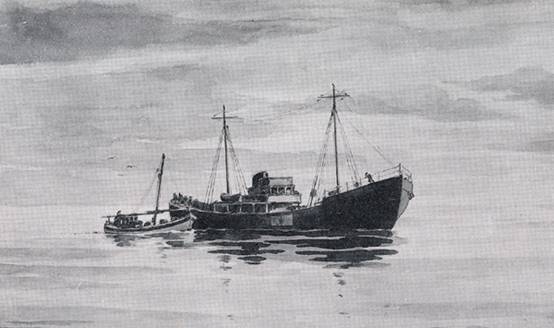
(HMS) Tarana - rendezvous’ with “Sea Wolf”
(Note : Photo of a Painting – courtesy “Conscript Heroes”)
He says he patrolled a four mile stretch of shoreline for three hours, continually signalling the shore but got no reply. At 03.00 he withdrew and moved out to sea ready to try again the following night. Next night he returned, again at midnight, and patrolled for two hours until forced to leave the area by the arrival of what he suspected to be two patrol boats. At that point he decided to give up and sent a radio message to Gibraltar saying that he was coming home. At 11.30 on Friday 9 October, Lukasz received a radio message asking him to return to Canet Plage as the Rosalind people had been waiting for him two nights already. He turned his ship around and arrived off the Tet estuary at a quarter past midnight on Monday 12 October. This time his signal was answered immediately and he duly sent his dinghy ashore to start loading the escapers. Alex (Jacques) Wattebled's account in 'Jacques, l'ami d'Achille' gives details from the point of view of the PAO men on shore. He says that on Thursday morning, he was the first to arrive at Perpignan along with two British servicemen. He took them by tram to Canet and put them into a room at the Hotel du Tennis. That afternoon, he returned to Perpignan and met Albert [Robert Leycuras] and Renée [Louis Nouveau's wife] who had brought three 'aviators' from Marseille, who Jacques then took back to the hotel. More men were brought down over the next three days. On Sunday evening, Joseph [O'Leary] arrived with the last of the men. The embarkation was planned for two o'clock Monday morning. The men were divided into groups to go down to the beach and at one o'clock, le chef [O'Leary] went first with ten British servicemen, then Jean [Louis Nouveau] with six others then Albert with another six and finally Jacques took the last ten. They crossed the river [Tet] in silence. Two o'clock and no signal, three o'clock, four o'clock, nothing. At four-thirty in the morning they returned to the hotel. The guides stayed with the evaders all day Monday and that night went back to the beach where they waited in vain until half past three. The servicemen didn't actually stay in the Hotel du Tennis, they were all kept in a small bungalow nearby, while the guides (and French speaking Lucien Dumais) stayed in the Hotel itself. On the Tuesday morning, Jacques went into Perpignan with Chouquette [Mme Lebreton, owner of the Hotel du Tennis] to buy food for the men. When they got back, the chef at the hotel prepared an evening meal for thirty-six men who all ate together. That night they went down to the beach once more, again with no result. On Wednesday night, and again Thursday night, Jacques went to the beach with just the Abbé [Josef Myrda]. By this time Joseph [O'Leary] had gone back to Marseille to see what he could find out, and Jacques telephoned him there. On Saturday (10 Oct) O'Leary returned to Canet Plage with John Peter [Louis Nouveau]. They had contacted Gibraltar [via Philippe Valat, the BCRA radio operator] and been told the ship had been there as arranged but had not had any response to their signals. Now she was returning to try again and would be there either Saturday (unlikely) or Sunday night. That evening O'Leary, Louis Nouveau and Jacques went down to the pickup point just in case Seawolf arrived early. The three men separated along the beach and suddenly Jacques heard two men speaking Spanish - but who they were remains a mystery. At three o'clock they returned to the hotel. The following night (Sunday) at half past midnight, everyone (even Chouquette) went down to the beach. O'Leary ordered them to spread along the beach at hundred metre intervals to watch for signals. Jacques (who apparently never saw any signals) says he was patrolling between the groups when he spotted a black shape in the water and realised it was a small boat not showing any lights. He waded into the sea towards it and saw a sailor in British Naval uniform right in front of him. The sailor called out the password "Ou sont les fraises?" and Jacques replied with "Dans le jus" and contact with Seawolf's dinghy was established. Lucien Dumais also claims to have spotted a boat in the darkness (it was just three days into a new moon) but no light signals, and says he wasn't the only one. He then heard the whistle which was the signal for the men spread along the shore to regroup.
Why Seawolf and the shore party failed to make contact on either of the first two nights is not known for sure but there are some possible contributing factors. The pick-up point for Rosalind, although described as being Canet Plage, was changed slightly from the beach used for Operation Titania. This time the men were to be collected from further north, across the River Tet, which has two estuaries, both of which the escapers had to wade through, to what is today known as Ste Marie Plage.
Though Lukasz (who had also been aboard Seawolf for the Titania operation) is adamant in his report that he had the right beach on each occasion, it would have been very easy for Seawolf to make a navigational error. In Kradewski's report on Titania, he commented that the whole of this featureless coastline had lights shining from shore and he had great difficulty in distinguishing the shore party's signals. He based his approach on the red flashing lights from a fishing village some 4 kms north - presumably Barcarès - but it was the cries and singing they heard from the beach that confirmed he had found the rendezvous point.
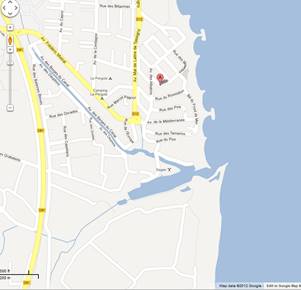
He also reported that the night was so clear [three nights before a full moon] that his vessel could be seen from shore as far as a mile out sea. Another possibility is a misunderstanding about the timing. Jacques says they first went to beach on the Monday morning (Sunday night) and since Seawolf didn't arrive until the Monday night, that was never going to work. Jacques also says the rendezvous was planned for two o'clock in the morning whilst Lukasz says midnight. On the Monday night, Lukasz says he patrolled up and down a four mile stretch of the coastline from midnight to three o'clock. As the shore party didn't arrive until about two o'clock, that didn't leave much time to make contact. Even walking to the beach would have introduced a margin for error, since it was about an hour's walk from the hotel, along the sandy shoreline and across two rivers, in silence and in the dark, to the actual pickup point. Then on the Tuesday, Jacques again says they went to the beach at two o'clock, by which time Seawolf was already withdrawing because of the two patrol boats. It is also possible there was some confusion over the times themselves - were they using GMT or local time, which would have been two hours ahead of GMT. Ron Stephens says Tarana used local times when operating in the Mediterranean but I don't know if Seawolf did the same. On balance however, since the previous Titania operation went smoothly enough, either navigational error or inability to distinguish the shore party's signals, seem the most likely reasons. A total of thirty-two servicemen were picked up that night - eighteen escapers (mostly soldiers) from Fort de la Rivère, and Pte Richard Watson from la Duchère, and thirteen evaders, all but two of whom were airmen. Josef Myrda, the Polish priest from Nice who had been instrumental in the de la Rivère escape and was by then brulé, was also taken off along with a French merchant navy officer”.
(Note : The above is a précis from the book “Conscript Heroes”)
(HMS) Tarana ( Note : From the book, “HMS Tarana – Under Two Flags” by R.S.Stevens- above. Deceased.)
HMS Tarana was a clandestine, requisitioned Portuguese trawler whose role was to help escaping prisoners and others from occupied France. When SeaWolf rendezvoused with Tarana it took them on to Gibraltar, and so Home.
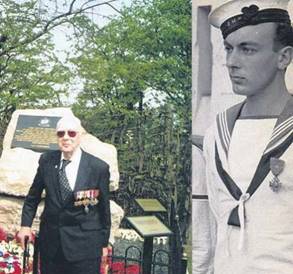
The next entry in Sgt Williams’ logbook records…...19.10.42 -Sunderland' L' -Pilot Flt/Lt Rees- Gibraltar to Poole Harbour -11.1/2 hrs....
The Evaders Reports tell us that the crew (evaders) left Gibraltar on the 18th October 1942 and reached Poole on the 19th October 1942. In just under two months from their last Operation they were back in Britain. The WO28 file numbers given are for those who evaded, and are publicly available for researchers through the National Archives at Kew.
1193117 Sgt DA Baker – Captain (Pilot Evasion Report 3311/919
NZ 41530 Sgt FJ Berthelsen – Observer Evasion Report 3311/917
574193 Sgt J B Downing - F/Engineer POW
993644 H Williams - WOp Evasion Report 3311/920
1011435 G Robinson – A/G Evasion Report 3311/918
1379417 Sgt T J Jenkins - A/G Evasion Report 3311/916
1376387 F/Sgt V S Wood - A/G POW
The Night Fighter.
Reinhard Kollak
(1915 - 1980)
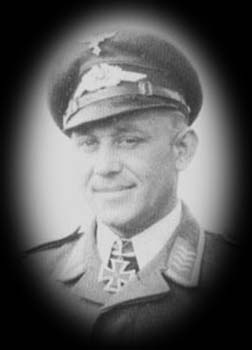
Stabsfeldwebel
ZG1, NJG1, and NJG4 NJG5
+250 Combat missions, 49 victories
Reinhard Kollak was born in (East Prussia), on March 28, 1915 and began his military career when he joined the Reichswehr. Two years later, in 1935, Kollak was transferred to the Luftwaffe where he received training as a fighter pilot.
After completing his training in the spring of 1940, Kollak was appointed to serve on the I / ZG 1 ( Gruppe I of Zerstörergeschwader 1 flying Me 110s) unit which participated in the Campaign of France . However, in October 1940, Kollak was transferred, along with his Bordfunker (Radio Operator) to the newly created 1./NJG (1st Staffel of Nachtjagdgeschwader 1), which began operating Me 110 night fighters.
Having gained his first victory on the night of 16/17.06.1941, Kollak reached the end of that year with a total of eight kills. After moving to 7./NJG 4 on 01.04.1942, he would get another five victories in 1942, being awarded the Award of Honor of the Luftwaffe on 18/09/1942. In July 1943, Kollak had raised his total to 27 victories, and was with the German Gold Cross on 05/29/1943. In mid-August 1943, he was transferred to the 8./NJG 4 and, finally, after 30 victories at night, Oberfeldwebel Reinhard Kollak was awarded the Knight's Cross order of the Iron Cross on 08/29/1943. Kollak had his best performance on the night of 18/19.07.1944 when he claimed four Allied bombers. That this quiet and thoughtful son of a farmer was one of the most experienced pilots from his Gruppe is indicated by the award of the Oak Leaves to the Knight's Cross (the war ended before his recommendation was approved).

In the photograph, Reinhard Kollack may be seen wearing the German Cross in Gold, awarded on 12 April 1943, and the Knight's Cross which he received on 29 August 1943 when his tally had increased to 29 victories
Night Fighter Record.
.Kollak was the most successful pilot of III./NJG4 and finished the war with a total of 49 night victories. In 250+ combat missions, all victories were Night victories. His first known victory, was a Whitley at Houthalen, 10 km NNE of Hasselt, on 17 June, 1941. The next, a Stirling I of RAF No. 149 Sq. at Thieulain (Hainaut), 12 km E of Tournai Belgium, by Leuze, 27 km northwest of Mons at 3,600 metres, the night of 24-25 August, 01.46hrs, 1942. (OJ-R)
Another victory, a Stirling I of RAF No. 149 Sq. at Tongrinne, 8 km southwest of Gembloux Belgium the night of 16-17 September, 1942. Another victory, a Lancaster on 16-17 September, 1942. On 19 September, 1942, he downed a Stirling 6 km NE of Revigny. His 20th (?) victory, a Lancaster SE of Metz on 24 February, 1944. A Lancaster 3 km S of Beaumont on 1 May, 1944. A 2nd Lancaster, same day, 3 km SW of Chateaudun. Another double victory, both "4 mots"; one at Bar-le-Duc, the other E of St Dizier, on 15 July, 1944. Four "4 mots" on 19 July, 1944; all in the Rommily/St Dizier areas. Bowers/Lednicer, 49 victories.
His Aircraft.

Messerschmitt Bf 110C Zerstörer 7. /NJG4 (3C+LR) Reinhard Kollak 1942
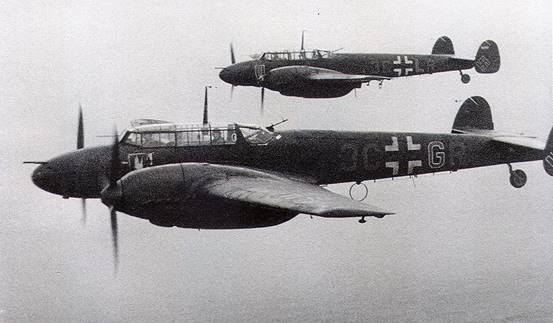
(Note: Photograph above. Two Bf 110C night fighters of 7./NJG4 in the summer of 1942. The pilot of 3C+GR, the aircraft nearest the camera is not known, but 3C+LR in the background was flown by Ofw. Reinhard Kollak and is shown here with ten victory bars on the tail. Note the matt black camouflage and lack of “Lichtenstein” radar.” Source unknown – similar to illustration in Dr. T. Boiten’s book - credited to J.-B Frappe, via Jean Hallade.
Kollack claimed his first night victory while flying as a Feldwebel with I./NJG1 when he destroyed a Whitley in the early hours of 17 June 1941. He remained with I./NJG1 when it was redesignated 7./NJG4 in May 1942 and on the night of 24/25 August 1942, shot down a Stirling as his tenth victory( OJ-R). This photograph must, therefore, have been taken soon afterwards as Ofw. Kollak's eleventh victory was achieved shortly after midnight on 16 September).
Stabsfeldwebel Reinhard Kollak died of natural causes in Bad Godesberg (West Germany) on February 6, 1980, at 64 years of age.
So this is the story of an ordinary Bomber crew, who had the most extraordinary adventures. Our thanks go to the brave men and women of Belgium and the Pat O’Leary line in France, for their safe return. There is still scope for a lot more research on this crew, specifically:
Their ‘Record of Service’ documents
Their background and pre service careers
Their Service Training and locations
Their subsequent Service History (Evaders)
Their subsequent History (POWs)
This document has been compiled by me with the aid of:
Mr George Worrall, who instigated this research and provided material
Mrs Vivien Wright, (nee Williams, Daughter of Sgt H. Williams)
John Johnston, who guided and advised me throughout this research
My thanks to them all.
Alan Fraser.
149 Sqn Historian.
Sources:
Chorley’s BCL Vol 3.
149 Sqn ORBs
RAF Lakenheath ORBs
Conscript Heroes. by Peter Scott Janes, edited by Keith Janes
Kraken Luftwaffe Archives
Dr. Theo Boiten’s book, “Nachtjagd War Diaries,” Vol 1.
The Bomber Command War Diaries: by Middlebrook & Everitt
The Stirling Story, by M.J.F. Bowyers
‘Footprints on the Sands of Time’ (RAF Bomber Command Prisoners of War in Germany 1939-1945) by Oliver Clutton-Brock.)
Acknowledgements:
Mrs V Wright (nee, Williams) Daughter of Sgt Williams
Keith Janes “Conscript Heroes”, Editor
Bruce Bolinger WWII Netherlands Escape Lines
John Johnston “Strong by Night”, 149 Sqdn History.
Diana Morgan E.L.M.S.
Websites:
http://www.conscript-heroes.com
http://users.skynet.be/bk212103/hebergeur-fourez-radoux.html (French)
http://www.rafcommands.com/forum/showthread.php?10614-Stirling-W-7572
http://aircrewremembrancesociety.com/Kracker/LuftwaffeGermanPilotsK.html
http://www.asisbiz.com/il2/Bf-110/Bf-110-NJG4.7-%283C+LR%29-Kollak.html (English/Portuguese)
http://www.ww2escapelines.co.uk/escapelines/
Return to Index
|
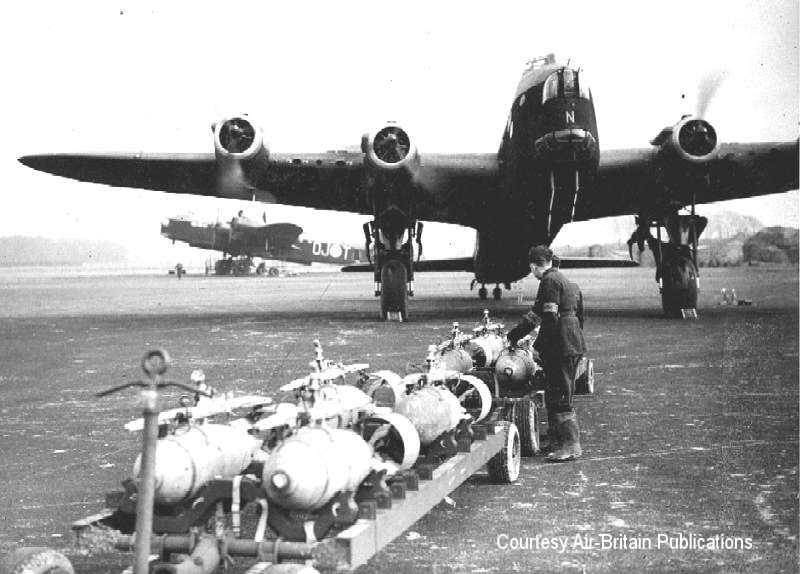 Stirling Pilott
Stirling Pilott 
 Stirling Pilott
Stirling Pilott 